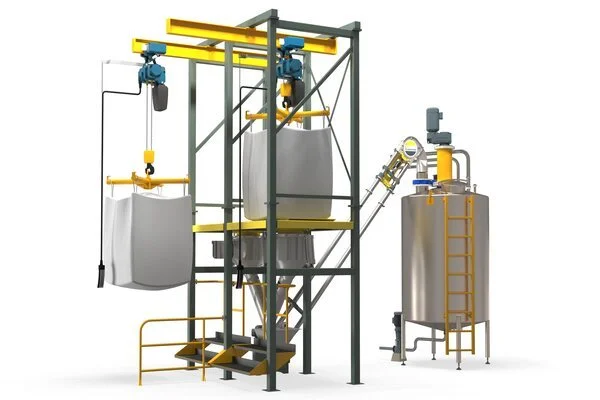Bulk Material Handling System
Bulk material handling systems are a branch of engineering concerned with the design of equipment for handling dry materials. Bulk materials are powdered, Granular, or Lumpy dry materials that are kept in heaps and are powdery, granular, or lumpy. Minerals, ores, coal, cereals, woodchips, sand, gravel, clay, cement, ash, salt, chemicals, grain, sugar, flour, and stone in loose bulk form are examples of bulk material handling systems.
It can also refer to how mixed wastes are handled. Food, Beverage, Confectionery, Pet food, Animal feed, Tobacco, Chemical, Agricultural, Polymer, Plastic, Rubber, Ceramic, Electronics, Metals, Minerals, Paint, Paper, Textiles, and other sectors that process bulk materials rely on bulk material handling systems.
Bulk materials are dry solids that come in powder, granular, or lumpy forms. The particle components of a bulk substance are too tiny to count individually, hence these materials are often kept in heaps or within silos. Bulk materials act as fluid while flowing, which is why they are frequently routed through Powder transfer systems.
Bulk materials cannot be transported easily unless adequate containers are used. This is particularly true for fine grains and powders. To avoid spillage and contamination, these products are often transported in closed or sealed containers. However, a bulk material handling system is the most effective way to convey powdered bulk materials inside a facility for processing.
A Bulk Material Handling System's primary role is to continually transport and provide bulk materials to units in processing facilities. Storage and mixing are examples of secondary functions. Raw materials (Such as bulk solids and powders) are received from trucks, ships, or trains in a conventional bulk material handling system.
They are then unloaded and transported to a yard or storage facility, generally utilizing a conveyor system. Typically, the materials are kept in stockpiles. An automated reclaimer or a gravity-reclaim setup comprised of reclaiming tunnel hoppers and feeders can be used to reclaim material from the stockpile. It is subsequently transported to the processing plant.
This is true for the majority of bulk material handling systems, whether used in processing applications or to move/store a finished bulk product. The supply chain, which provides raw materials for production and transports finished goods to clients, is an essential component of industrial or manufacturing processes. The supply chain handles and travels through every form of machine, implement, part, or component.
The bulk material handling system, which is a huge network of professionals and equipment that ensures accurate part placement and inventory management, lies at the heart of the supply chain.
The equipment used to move and transport items to customers or manufacturing is at the heart of a bulk material handling system. The right equipment selection is crucial to the smooth running of the supply chain and material handling process. The right sorts of equipment have an impact on all elements of a company's processes, from the beginning to the end.
BENEFITS OF BULK MATERIAL HANDLING SYSTEMS
The bulk material handling system is the process of transporting commodities securely inside a manufacturing or processing facility. The conveying parameters of the system, such as conveyance speed or flow rate, are determined by the materials' properties. Furthermore, the type of bulk material determines the sort of protection that should be provided by the handling system.
Because some bulk materials are abrasive and potentially damage the system's components, ceramic linings or coatings are occasionally utilized in systems. The transportation of hazardous bulk goods, such as poisonous or combustible compounds, necessitates extreme caution. For example, handling sulfur powder necessitates temperature control, which necessitates precise calibration of the flow rate.
To maintain the safety of some bulk materials, particular handling is required. This is especially true for bulk commodities utilized in the food industry. Food-grade bulk material handling necessitates that the equipment and its interior components adhere to specified hygienic norms and regulations.
Similarly, bulk material conveyance requirements for the pharmaceutical business include high hygiene standards, comprehensive product containment, and contamination-free operations. As a result, the equipment utilized to handle bulk materials such as wood chips or sand will have different requirements than that required to handle cereals or raw materials used in medicines.
Because of the particular characteristics of each facility, as well as the qualities of the material handled, developing equipment precisely for its intended purpose is critical. Plant managers may frequently gain the following benefits by using appropriately built equipment.
Lowers manual labour and costs
Because few persons are required to complete a given operation, Bulk material handling systems assist in minimising manpower, resulting in lower labour costs.
Inventory management
A bulk material handling system provides improved control and precision, ensuring that there are no misplaced products, damages, or other unneeded difficulties.
Doubles productivity
When compared to people, bulk material handling systems can operate nonstop since they are automated. This increases productivity.
Improve worker safety
When compared to manual material movement equipment, automated bulk material handling systems help reduce the chance of injuries, hence improving worker safety in the workplace.
Components Of Bulk Material Handling System
Bulk material handling systems are typically made up of stationary machinery such as conveyor belts, screw conveyors, tubular drag conveyors, moving floors, top loaders, stackers, reclaimers, bucket elevators, truck dumpers, railcar dumpers or wagon tipplers, ship loaders, hoppers and diverters, and various mobile equipment such as loaders, mobile hopper loaders/unloaders, and various shuttles, as well as storage facilities such as stockyards, storage silos, Integrated bulk storage, conveying, and discharge, are all features of advanced bulk material handling systems.
Belt conveyor
A belt conveyor, which is designed for continuous operation, may be utilized in a broad variety of capacities and lengths, and its length can range from a few meters to tens of kilometres in the bulk material handling system. The belt loops around a pulley at each end of the conveyor.
Belt conveyors are used in bulk material handling systems. The primary belt conveyor components, such as idlers, rollers, pulleys, bearings, shafts, and belts, must work under dynamic loads and extreme circumstances to retain reliability.
Rolling element bearings are frequently used in various equipment and can have a limited life, even as little as a few months if subjected to dynamic or unexpected stresses that are not acceptable for their design. Shafts are comparable. Belts can also be damaged and destroyed when subjected to loads that are not adequate for their design, when exposed to corrosion, or when used in situations that are not acceptable for their material. Many additional elements must be addressed in conveyor belt design, operation, and dependability.
Conveying system
Conveyors are used in a variety of bulk material handling systems. A bulk material handling system makes use of pneumatic conveyors. Drag chains, bucket elevators, and screw conveyors are some more types of conveyors. It should be noted that some of these conveyors are still used in some systems' equipment.
The driving unit of a conveyor can be designed in a variety of ways. Power is provided by a direct-coupled motor gearbox or a direct- or parallel-shaft drive, which operates the drum through an appropriately sized coupling in typical designs. Initiation capability, particularly the demand for start-up under full load, is an important consideration in the design and size of drive units. A fluid coupling is used on many small and medium-sized conveyors to help with start-up and transient operations.
Material Storage
The use of bulk material handling systems After gathering and transporting the component, a temporary storage container is required. This is handled by material storage. It contains silos, hoppers, small bins, and other equipment. Stacker/reclaimer machines are used in bulk material handling systems to stack and store items in stockpiles and stockyards, as well as to reclaim materials as needed.
For decades, separate stacker and reclaimer machines were employed, but newer designs favour integrated stacker/reclaimer machines. They are effective choices with a high degree of operational flexibility. Material is fed onto a boom conveyor and dispersed in stockyards during stacking mode. The boom conveyor discharges materials onto the stockpile conveyor for feeding to bunkers, silos, or customers through other conveyors and transfer points when in reclamation mode.
Our Principal
Floveyor in association with Kiron Food Processing Technologies offers a complete bulk material handling system solution. For full, one-of-a-kind solutions, our specialists combine the strengths of scalable material handling systems. Our objective is to use these tools to assist firms across a wide range of industrial areas in becoming industry leaders.








